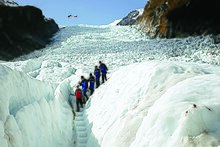Heli hiking

Heli hiking is a recreational activity in which a helicopter is used to access remote areas of the back country for hiking. These locations are typically inaccessible through other forms of transportation. Along with heli skiing, heli hiking is one of the most popular forms of heli tourism.[1][2] It falls within the broad category of amateur adventure or activity-based tourism.[3][4][5] It is a seasonal commercial backcountry industry, which also includes mountaineering and kayaking.[6]
Heli hiking is a form of mountain recreation in the mountainous regions of New Zealand and the Bugaboos in Canada.[7][8] It is a form of glacier tourism in locations including Glacier Bay National Park, Westland Tai Poutini National Park, and Ilulissat Icefjord.[9]
History[]
The first heli hiking tour took place in the summer of 1978 at the Cariboo Lodge, operated by Canadian Mountain Holidays.[10] It was introduced as and continues to be the summer counterpart to heli skiing.[10]
Marketing[]
Heli hiking has been marketed toward women.[11] It is popular among young female tourists in New Zealand.[12]
The activity is advertised as a luxury tourist attraction.
Environmental impact and regulation[]
Due to the disturbances caused by helicopter overflights, heli hiking is considered by authorities to be a possible cause of the decline of the mountain goat population in southeastern British Columbia and is opposed by the East Kootenay Environmental Society.[13][14][1] It has also impacted British Columbia's Graham caribou population through displacement and interruption of migratory cycles.[15]
In the North Cascades, heli hiking has been discouraged by the United States Forest Service.[16] However, there is still minimal regulation of heli hiking and other mountain recreation activities for environmental protection.[4]
References[]
- ^ a b Hudson, Simon; Miller, Graham A (2005-04-01). "The responsible marketing of tourism: the case of Canadian Mountain Holidays". Tourism Management. 26 (2): 133–142. doi:10.1016/j.tourman.2003.06.005. ISSN 0261-5177.
- ^ Thirkell, K. (1999). View from the top. The Ottawa Citizen, October 2, K1.
- ^ Shephard, Graham, and Sarah Evans. "Adventure tourism–hard decisions, soft options and home for tea: adventure on the hoof." Niche Tourism. Routledge, 2007. 210-218.[1]
- ^ a b Nepal, Sanjay K.; Chipeniuk, Raymond (August 2005). "Mountain Tourism: Toward a Conceptual Framework". Tourism Geographies. 7 (3): 313–333. doi:10.1080/14616680500164849. ISSN 1461-6688. S2CID 154778170.
- ^ Kariel, Herbert G. (1984). "Tourism in the Canadian Cordillera: A Synthesis of Visitor Characteristics and Areal Use Patterns". Mountain Research and Development. 4 (3): 213–228. doi:10.2307/3673142. ISSN 0276-4741. JSTOR 3673142.
- ^ Williams, Peter W.; Penrose, Robert W.; Hawkes, Suzanne (1998-10-15). "Shared decision-making in tourism land use planning". Annals of Tourism Research. 25 (4): 860–889. doi:10.1016/S0160-7383(98)00037-1. ISSN 0160-7383.
- ^ Booth, Kay L.; Cullen, Ross (November 2001). "Managing Recreation and Tourism in New Zealand Mountains". Mountain Research and Development. 21 (4): 331–334. doi:10.1659/0276-4741(2001)021[0331:MRATIN]2.0.CO;2. hdl:10182/523. ISSN 0276-4741.
- ^ Moure, Celeste. "Heli-Hiking in the Canadian Rockies". National Geographic.
{{cite web}}: CS1 maint: url-status (link) - ^ Shijin, Wang; Jia, Xie; Lanyue, Zhou (2020-12-01). "China's glacier tourism: Potential evaluation and spatial planning". Journal of Destination Marketing & Management. 18: 100506. doi:10.1016/j.jdmm.2020.100506. ISSN 2212-571X.
- ^ a b Richins, Harold; Hull, John (2016-02-19). Mountain Tourism: Experiences, Communities, Environments and Sustainable Futures. CABI. ISBN 978-1-78064-460-8.
- ^ Bond, Marybeth (2007). 50 Best Girlfriends Getaways in North America. National Geographic Books. ISBN 978-1-4262-0051-9.
- ^ Shipway, Richard; Fyall, Alan (2013-05-07). International Sports Events: Impacts, Experiences and Identities. Routledge. ISBN 978-1-136-47563-4.
- ^ Goldstein, Michael I.; Poe, Aaron J.; Cooper, Erin; Youkey, Don; Brown, Bridget A.; McDonald, Trent L. (2005). "Mountain goat response to helicopter overflights in Alaska". Wildlife Society Bulletin. 33 (2): 688–699. doi:10.2193/0091-7648(2005)33[688:MGRTHO]2.0.CO;2. ISSN 1938-5463.
- ^ Poole, K. G., and Ian Adams. "Mountain goat monitoring in Canadian Mountain Holidays’ Bugaboo and Bobbie Burns heli-hiking areas, East Kootenay, September 2002." Unpublished report for Canadian Mountain Holidays, Cranbrook British Columbia (2002).
- ^ Culling, Diane E., and Brad A. Culling. SEASONAL HABITAT USE AND MOVEMENTS OF GRAHAM CARIBOU 2001 to 2003. http://www.env.gov.bc.ca/wildlife/wsi/reports/4552_WSI_4552_RPT_2001-2003.PDF
- ^ Burr, Eric. "Heli-Ski Survival Guide." https://arc.lib.montana.edu/snow-science/objects/issw-1996-207-208.pdf
- Hiking
- Tourism
- Recreation
- Adventure travel